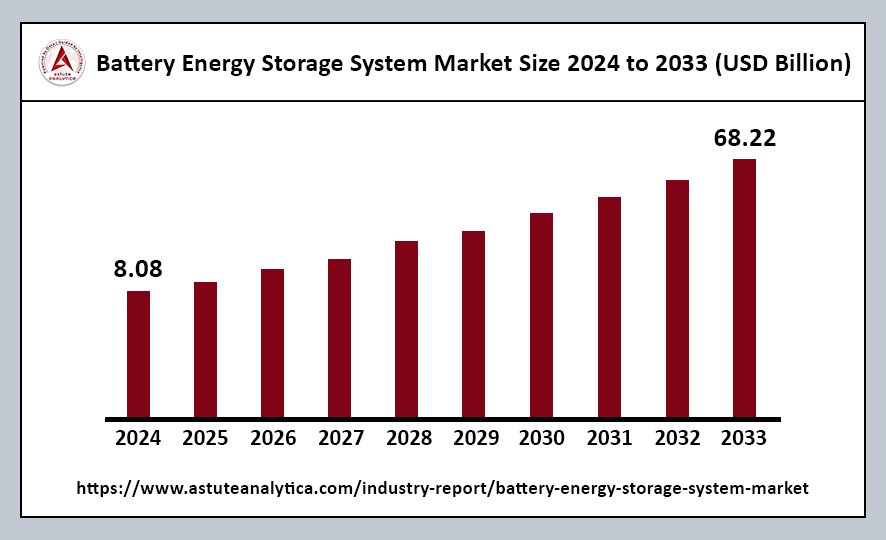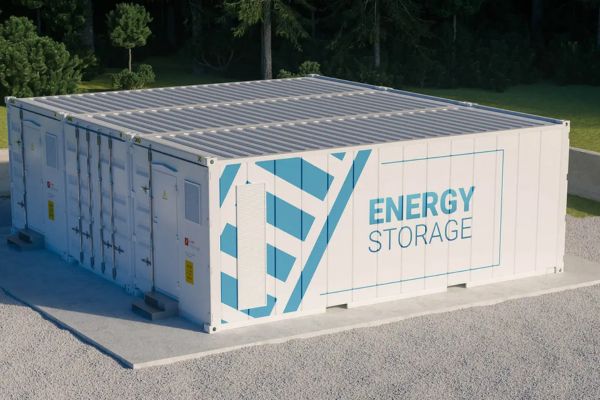The global battery energy storage system market was valued at US$ 8.08 billion in 2024 and is projected to reach a market valuation of US$ 68.22 billion by 2033. This growth represents a compound annual growth rate (CAGR) of 26.75% during the forecast period from 2025 to 2033.

The Battery Energy Storage System (BESS) industry is undergoing significant transformation, propelled by technological advancements and a surge in grid modernization initiatives. Lithium-ion (Li-ion) battery pack prices have seen a remarkable decline of 20% from 2023, reaching a record low of $115/kWh.
This marks the most substantial annual decrease since 2017. It is important to note that this price reflects a global average, which can vary by geography and application area. The price reduction has been largely facilitated by ongoing research and development efforts that focus on several key areas. These include improving battery materials, reducing the usage of non-active materials, and enhancing cell design and production yields.
Battery Energy Storage System Market Key Takeaways
- By Connection Type, On-grid installations are the predominant choice in the battery energy storage system market, seamlessly integrating with existing power networks to manage load fluctuations and stabilize frequency.
- By Ownership, Utility-owned storage solutions lead strategic projects, allowing grid operators to maintain direct control over peak shaving, load balancing, and emergency reserves.
- By Application, Commercial and utility applications form the backbone of the battery energy storage system market, driving the demand for large-scale and high-capacity installations.
- By Battery Type, Lithium-ion batteries dominate the market, commanding over 98% share in today’s battery energy storage systems, thanks to their high energy density and continuous innovation.
Regional Analysis
Asia Pacific’s Leadership in Battery Energy Storage
Asia Pacific holds a significant leadership position in the battery energy storage system market, commanding a 33% share. This dominance is supported by vast manufacturing facilities and strong policy directives aimed at fostering growth in the sector.
- China’s Dominance in Lithium-Ion Production: China leads the charge with an impressive annual lithium-ion production exceeding 940 gigawatt-hours. This growth is driven by industrial giants that cater to both domestic and international projects, solidifying the country’s role as a key player in the global battery market.
- India’s Large-Scale Battery Deployments: In India, the installed solar capacity has surpassed 97 gigawatts, leading to an increasing demand for large-scale battery deployments. These initiatives aim to stabilize the rapidly growing renewable sector, with pilot programs being introduced to support rural microgrids.
- Japan’s Focus on Battery Technology R&D: Japan continues to be a frontrunner in battery technology research and development, housing approximately 10 advanced research centers dedicated to exploring novel chemistries, including sodium-ion and solid-state cells. As a result of this commitment to innovation, Japan is at the forefront of battery advancements.
- South Korea’s Robust Frequency Management Systems: In South Korea, grid operators are implementing robust frequency management systems supported by extensive battery backups. These systems ensure consistent electricity supply in densely populated metropolitan areas, enhancing grid reliability in urban centers.
North America’s Vital Battery Energy Storage System Markets
North America features critically important battery energy storage system markets, particularly in the United States and Canada. Statewide legislative movements are establishing storage mandates that drive the development of utility-scale installations across the region.
- California’s Progressive Energy Policies: California, known for its progressive energy policies, boasts operational battery projects that collectively store multiple gigawatt-hours of energy. Many of these projects are integrated with extensive solar farms in the Mojave Desert, maximizing the state’s renewable energy potential.
- Incentives on the East Coast: Along the East Coast, states such as New York and Massachusetts are expanding incentives for behind-the-meter systems. These systems aim to curb urban load spikes and reduce strain on the grid, promoting a more stable energy environment in densely populated areas.
- Canadian Provincial Initiatives: In Canada, provincial-level initiatives in Ontario and Québec are driving the proliferation of large-scale and residential battery systems in conjunction with hydropower resources. These efforts support a cleaner energy grid and enhance energy reliability for residents.
- Corporate Investments in On-Site Battery Solutions: American corporations, ranging from tech giants to logistics firms, are heavily investing in on-site battery solutions. These investments aim to mitigate demand charges and enhance sustainability credentials, reflecting a growing commitment to energy efficiency and renewable integration in the corporate sector.
Europe’s Steady Rise in Battery Deployment
Europe continues its steady rise in battery deployment through supportive regulations and cross-border collaborations. This growth is not only evident in industrial centers but also in suburban neighborhoods, where energy storage solutions are becoming increasingly integral to local energy management.
- Germany’s Robust Market: Germany maintains a robust market for rooftop solar plus storage and grid-scale installations. This dual approach allows for efficient energy use and enhances the country’s commitment to renewable energy adoption.
- United Kingdom’s Pioneering Balancing Services: The United Kingdom has taken the lead in offering battery-enabled balancing services, providing incentives for investors to deploy advanced storage units near major transmission nodes. This strategy enhances grid stability and supports the integration of renewable energy sources.
- Advanced Flow Battery Experiments in Scandinavia: In Scandinavia, countries like Sweden and Finland are experimenting with advanced flow batteries for extended-duration power supply. These technologies align well with their renewable-heavy grids, providing a reliable solution for energy storage and distribution.
- Southern Europe’s Solar Integration: Meanwhile, southern European nations, including Spain and Portugal, are integrating energy storage with their rapidly growing solar capacity. This integration is crucial for managing peak-season demands, ensuring that the energy produced during sunny periods can be effectively utilized throughout the year.
Top Trends Escalating the Battery Energy Storage System Market
Surging Interest in Second-Life Vehicle Batteries: There is a growing interest in utilizing second-life vehicle batteries for stationary applications. These batteries, which have completed their initial lifecycle in electric vehicles (EVs), can be repurposed for energy storage in homes, businesses, and grid applications.
Ongoing Digitization of Energy Systems: The ongoing digitization of the energy sector is facilitating the connection between smart meters and energy storage control systems. This integration allows for real-time monitoring and management of energy consumption and storage, leading to more efficient energy use.
Accelerating Adoption of Hybrid Battery Technologies: The adoption of hybrid battery technologies that span multiple chemistries is accelerating. These hybrid systems combine the strengths of different battery types—such as lithium-ion and flow batteries—to enhance performance, cost-effectiveness, and longevity.
Expanding Electric Vehicle Fleets: The rapid expansion of electric vehicle (EV) fleets is driving the demand for robust battery storage solutions. As more consumers and businesses transition to EVs, the need for efficient charging infrastructure and energy storage systems becomes critical.
Focus on Resilient Grids: Amid unpredictable climatic disruptions, there is a heightened focus on building resilient grids. Energy storage systems play a key role in enhancing grid stability and reliability during extreme weather events.
Decentralized Energy Initiatives: There is a strong impetus for decentralized energy through advanced community-based storage initiatives. These initiatives empower local communities to generate, store, and manage their own energy resources.
Battery Energy Storage System Market Segmentation
By Connection Type
On-grid installations dominate the battery energy storage system market, primarily due to their seamless integration with established power networks. These systems effectively manage load fluctuations and ensure frequency stabilization. Several European nations, including Germany, France, and the United Kingdom, rely on grid-connected storage to enhance renewable energy penetration.
By Ownership
Utility-owned storage solutions dominate strategic projects where grid operators aim for direct control over peak shaving, load balancing, and emergency reserves. The presence of cost recovery frameworks in regions like North America and parts of Europe fosters confidence among utility boards, enabling them to amortize expenses over extended time periods.
By Application
Commercial and utility applications form the bedrock of the battery energy storage system market, deploying large-scale, high-capacity installations to manage demanding load profiles. Utilities view battery arrays as a pivotal tool for load leveling, with over 60 utility sites worldwide experimenting with advanced dispatch algorithms to absorb surplus wind or solar output.
By Battery Type
Lithium-ion batteries command over 98% of the current battery energy storage system market. This dominance is driven by their high energy density and continuous innovation in technology. Tech firms have partnered with recycling specialists to recover essential minerals from used batteries. Notably, Redwood Materials claims to process thousands of tons of end-of-life battery packs each year.
Battery Energy Storage System Market Recent Developments
- SMA Solar and RheinEnergie Partnership: In April 2025, the system integration arm of SMA Solar and utility RheinEnergie partnered to deploy Battery Energy Storage System (BESS) projects in Germany. The two companies will co-develop BESS projects to be paired with renewable energy plants like wind and solar, as well as standalone BESS projects.
- BYD Energy Storage Launch: In March 2025, BYD Energy Storage launched the Battery-Box LV5.0+ Energy Storage System and Power-Box inverters at Solar & Storage Live Africa.
- Atlas Copco’s New BESS: In March 2025, Atlas Copco introduced a 1 MW battery energy storage system. The new ZBC 1 MW is built using the same advanced battery technology as Atlas Copco’s existing range of Energy Storage Systems (ESS). This system aims to deliver a reliable power source and enable users to reduce emissions by up to 90% while saving on costs.
- TotalEnergies Battery Projects: In March 2025, TotalEnergies launched 221 MW of Battery Energy Storage Projects in Germany. These projects amount to 221 MW of new storage capacity and involve an investment of €160 million. Kyon Energy developed these projects.
Top Players in the Battery Storage System Market
- ABB
- AES Energy Storage
- BYD Company Limited
- Contemporary Amperex Technology Co. Limited
- Enersys
- Exide Technologies
- General Electric
- HOPPECKE Batteries Inc.
- LG Chem Ltd.
- NEC
- Nidec ASI
- Nissan
- Panasonic Corporation
- Samsung SDI
- Tesla
- Other Prominent Players
Market Segmentation Overview
By Battery Type
- Lithium-ion Battery
- Lead Acid Battery
- Flywheel Battery
- Others
By Ownership
- Customer-owned
- Third-party Owned
- Utility-owned
By Connection Type
- On-grid
- Off-grid
By Application
- Residential
- Commercial
- Utility
By Geography
- North America
- Europe
- Asia-Pacific
- Latin America
- Middle East and Africa
Source: https://www.astuteanalytica.com/industry-report/battery-energy-storage-system-market

















